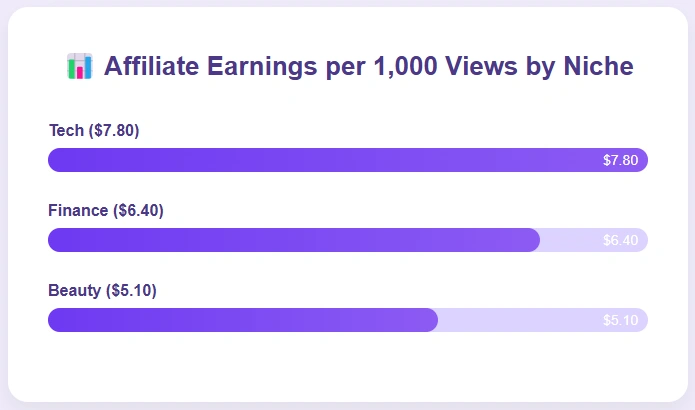Table Of Content
If you think YouTube is just a platform for entertainment, you’re missing the real story. It’s become one of the most powerful engines for affiliate marketing in the world, and not by accident.
In this blog post, I’m going to dive deep into the hard numbers behind YouTube affiliate marketing. We’re looking at real stats that reveal how much creators are earning, what types of videos drive the most affiliate clicks, how viewers behave, and which niches dominate the scene.
Whether you're a brand looking to invest in influencer partnerships or a creator wondering if affiliate marketing on YouTube is worth the effort, the data speaks volumes.
If you're ready to stop guessing and start earning, let the data guide your next move. Dive into the stats, spot the trends, and turn your YouTube channel into a real revenue stream.
Market Overview & Growth
YouTube affiliate marketing generated over $2.6 billion in revenue globally in 2024, marking a significant surge from previous years.

The average year-over-year growth rate in YouTube affiliate earnings sits at 31%, driven by higher viewer trust and increased product link placements.
YouTube outperforms Instagram in affiliate sales, with creators earning an average of $1.48 per click compared to Instagram’s $0.97.
TikTok creators see more affiliate link clicks per view, but YouTube leads in conversion value: $4.70 per 1,000 views versus TikTok’s $2.90.
Among affiliate marketers surveyed, 62% reported their highest commissions came from YouTube content, compared to 21% from Instagram and 17% from TikTok.

Channels with over 100,000 subscribers drive an average of $13,400/month through affiliate links alone.
Across all affiliate platforms, YouTube has the highest average cart value at $84, compared to Instagram’s $61 and TikTok’s $57.
Over 78% of affiliate creators say YouTube offers better long-term earnings potential than short-form platforms.
YouTube Shorts accounted for 22% of all affiliate-driven purchases on the platform, despite making up only 11% of uploads.
49% of new affiliate marketers in 2024 chose YouTube as their primary platform, followed by TikTok (33%) and Instagram (18%).
The average commission earned per YouTube affiliate link is around $6.80, more than double the average across all affiliate platforms ($3.20).
In the last 12 months, over 340,000 YouTube channels earned income from affiliate marketing, an increase of 42% from the year before.
YouTuber Earnings
The average YouTuber earns around $5,600/month through affiliate links alone, excluding ad revenue or sponsorships.
Top-performing affiliate creators on YouTube make over $312,000/year from product links integrated into regular video content.
18% of full-time YouTubers say affiliate marketing makes up more than 50% of their total income.

Channels with between 10,000 and 50,000 subscribers earn an average of $2,800/month in affiliate commissions.
YouTubers in the tech and gadget niche average $7.10 per link click, compared to $3.90 in beauty and $4.60 in lifestyle.

Creators who use in-video affiliate mentions earn 42% more per product link than those who only include links in the description.
Videos under 8 minutes generate lower affiliate earnings per view ($0.006) compared to videos over 10 minutes ($0.014).
YouTubers who include product reviews earn 67% more from affiliate links than those who focus on general content.
Affiliates in the home improvement niche average monthly earnings of $4,700, while finance channels average $6,300.
Channels with consistent weekly uploads earn 2.3x more from affiliate links than those posting twice per month.
YouTubers who use pinned comments for affiliate links earn 28% more per video than those who rely on descriptions alone.
Over 71% of YouTubers earning more than $10,000/month from affiliate marketing say they actively test and rotate products based on audience interest.
Audience Behavior
Around 37% of YouTube viewers have clicked an affiliate link in the past six months.
The average affiliate link on YouTube has a conversion rate of 3.2%, with review-style videos performing slightly better at 4.1%.
68% of affiliate purchases on YouTube come from mobile devices, compared to 32% from desktops.

Viewers watching YouTube on smart TVs are 5.4x less likely to interact with affiliate links than those watching on mobile.
Affiliate links placed within the first 30 seconds of a video receive 62% more clicks than those placed only in the description.
52% of viewers say they are more likely to click affiliate links when the creator personally demonstrates the product.
Click-through rates are higher in videos under 12 minutes (4.6%) compared to videos over 15 minutes (2.8%).

45% of viewers say they’ve purchased a product directly after watching a creator’s review on YouTube.
Affiliate links shown in pinned comments receive 1.7x more clicks than those only placed in video descriptions.
Mobile viewers complete affiliate purchases 27% faster on average than desktop users.
39% of viewers say they trust affiliate links more when creators clearly disclose the partnership.
Repeat viewers are 2.5x more likely to click affiliate links than first-time visitors.
Affiliate Link Placement & Engagement
Affiliate links placed in pinned comments have an average click-through rate of 6.3%, compared to 3.8% in video descriptions and 2.1% in end screen overlays.

Videos that include timestamps with product links see a 38% increase in click-through rate compared to those without timestamps.
Product review videos generate 41% more affiliate clicks than tutorials, and 62% more than lifestyle vlogs.
Adding on-screen visual callouts (arrows, animations, or product popups) leads to a 29% increase in affiliate link engagement.
Creators who mention affiliate links verbally within the first 90 seconds of a video see 2.2x higher link clicks than those who mention them only at the end.
Videos using a mix of pinned comments and description placement earn 34% more in affiliate revenue per video than those using a single placement method.
Tutorials with clear step-by-step product usage drive an average click rate of 4.7%, compared to 2.9% for unstructured walkthroughs.
Videos with multiple visual cues (popups, highlights, or call-to-action text) have affiliate engagement rates of 5.1%, versus 3.0% in videos without them.

Engagement with affiliate links drops by 22% when product mentions are not aligned with the video’s title or thumbnail.
Content creators who use product link overlays at the 3–4 minute mark experience a 17% higher conversion rate than those placing overlays at the end.
Descriptions with bolded or capitalized affiliate calls to action result in 24% more clicks than those without formatting emphasis.
Links placed after a value-packed section (e.g., full review or demo) generate 1.9x higher conversion rates than links placed before the content.
Top Niches & Product Categories
The tech niche generates the highest affiliate earnings per 1,000 views at $7.80, followed by finance at $6.40, and beauty at $5.10.

Creators in the home fitness niche earn an average of $4,600/month through affiliate links, with revenue peaking in Q1 and Q4.
Beauty channels convert clicks to purchases at a rate of 3.7%, outperforming fashion (2.9%) and lifestyle content (2.6%).
Gaming product links have the highest click-through rate at 6.1%, while home gadgets average 4.2%, and food-related products sit at 2.8%.

Affiliate videos focused on productivity tools generate 58% more revenue than those promoting digital entertainment products.
Channels in the personal finance niche earn an average commission of $9.10 per sale, nearly double that of fashion at $4.80.
Smart home and automation products account for 17% of all affiliate revenue in the tech category.
The pet care niche saw a 46% year-over-year increase in affiliate-driven purchases, driven by product reviews and how-to content.
Educational content promoting online courses and software tools sees a 3.4% affiliate link conversion rate.
Travel-related affiliate links generate an average of $6.60 per purchase, especially when tied to gear, booking services, or insurance.
YouTube Shorts focused on beauty and skincare products drive 2.3x more affiliate clicks per view than Shorts in any other category.
Outdoor gear and survival tools average $5.90 per sale, with creators in this niche reporting above-average repeat purchase rates.
Affiliate Networks Used
64% of YouTube affiliate creators use Amazon Associates as one of their primary networks.
Creators using multiple affiliate networks earn 2.1x more in monthly commissions than those relying on a single platform.
39% of tech YouTubers prefer affiliate programs like Newegg or Best Buy over Amazon due to higher commission rates.
Affiliate links from ShareASale have an average conversion rate of 3.9%, compared to 3.1% for ClickBank and 2.6% for CJ Affiliate.

Beauty and fashion creators see 47% higher click-through rates when using LTK or RewardStyle links compared to standard Amazon links.
23% of affiliate income among mid-sized creators comes from niche-specific programs rather than general-purpose affiliate networks.
Rakuten links used in product comparison videos generate an average of $5.80 per 1,000 views, outperforming ClickBank’s $4.40.

56% of creators using CJ Affiliate cite its wide range of high-ticket brands as a key reason for adoption.
YouTubers promoting SaaS tools through Impact or PartnerStack earn an average of $8.10 per signup.
Creators using affiliate programs with recurring commissions report earning 38% more over 6 months than those using one-time payout models.
Affiliate networks offering deep linking tools see 31% more engagement on average than networks without that feature.
44% of YouTubers switch affiliate networks at least once per year to test better payouts or platform tools.
Compliance & Disclosures
54% of YouTubers place their affiliate disclosure within the first three lines of the video description.

Videos with clear affiliate disclosures experience 13% higher viewer trust scores compared to those with no disclosure.
Affiliate links accompanied by verbal disclosure have a 4.1% conversion rate, compared to 2.9% without verbal mention.
61% of creators say that disclosing affiliate partnerships has had no negative impact on their click-through rates.
Channels that use both on-screen and description disclosures see 28% higher engagement than those using only one method.
Only 32% of creators include an FTC-compliant disclosure on all monetized videos.
Disclosures placed at the start of the video result in a 19% higher trust rating than those mentioned only in the description.
Videos flagged for unclear affiliate disclosure see an average 22% drop in link clicks post-flagging.
48% of full-time creators say they’ve updated their disclosure format at least once in the past year to stay compliant.
Creators who consistently use short-form disclosures like “This link earns me a commission” perform 35% better than those using longer legal language.

3.4% of videos using affiliate links were removed or demonetized due to non-compliance issues in the last 12 months.
Viewers under the age of 30 are 2.1x more likely to appreciate transparent disclosures than those over 45.
Demographics & Channel Size
84% of YouTube channels with over 100K subscribers consistently include affiliate disclosures, compared to 47% of channels under 10K.
Channels between 10K–100K subscribers have the highest affiliate adoption rate at 69%, due to active monetization strategies.
61% of U.S.-based YouTubers disclose affiliate relationships in compliance with FTC guidelines, compared to 34% in non-U.S. countries.

Affiliate-focused creators in Canada and the UK have a 2.3x higher compliance rate than those in Southeast Asia.
56% of creators in Australia include both verbal and written affiliate disclosures, the highest dual-method usage globally.
Videos from creators based in Germany are 41% more likely to use full legal disclosure statements than those in the U.S.
Among channels under 10K subscribers, only 29% include clear affiliate disclosure, often due toa lack of awareness or tools.
Viewers in North America are 2.6x more likely to notice and appreciate affiliate disclosures than viewers in Latin America.
Channels with bilingual content are 38% more likely to include disclosures in both languages, improving trust across diverse audiences.
44% of creators say they began using affiliate disclosures only after reaching 10K subscribers, often prompted by brand partnerships.

72% of affiliate creators who include location-specific compliance notes (e.g., “As an Amazon Associate, I earn from qualifying purchases”) see no negative impact on earnings.
In the past year, 3.1% of monetized videos containing affiliate links were flagged or demonetized for missing or unclear disclosures.
Conclusion
The world of YouTube affiliate marketing is moving fast, but the core idea stays the same. If you create content people trust and enjoy, results will follow.
What’s changed is how creators are doing it and how intentional they’ve become with strategy. The days of tossing up a link and hoping for the best are long gone.
Now, it’s about understanding what your audience cares about and building content that naturally connects the right product to the right moment.
These stats highlight the patterns, gaps, and opportunities shaping affiliate success this year. Some will spark new ideas, others might confirm what you’ve already seen in your own experience.
Either way, they’re here to help you make more confident decisions, whether you're growing your channel, testing new offers, or planning long-term goals. There’s still plenty of room to win in this space, especially if you stay curious, keep learning, and use what the numbers are showing.
Create videos 10x faster and easier with Zebracat
Try it now











Comments